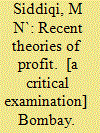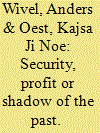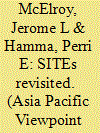|
|
|
Sort Order |
|
|
|
Items / Page
|
|
|
|
|
|
|
| Srl | Item |
| 1 |
ID:
186938


|
|
|
|
|
| Summary/Abstract |
The political connection between the state and firms in the context of China's corporate restructuring has been little explored. Using the clientelist framework and unpacking the incentives of both firms and the state, we analyse political connections as repeated patron–client exchanges where the politically connected firms can help the state fulfil its revenue imperative, serving as a failsafe for local authorities to ensure that upper-level tax quotas are met. Leveraging original surveys of the same Chinese firms over an 11-year period and the variations in their post-restructuring board composition, we find that restructured state-owned enterprises (SOEs) with political connections pay more tax than their assessed amount, independent of profits, in exchange for more preferential access to key inputs and policy opportunities controlled by the state. Examining taxes rather than profits also offers a new interpretation for why China continues to favour its remaining SOEs even when they are less profitable.
|
|
|
|
|
|
|
|
|
|
|
|
|
|
|
|
| 2 |
ID:
041079


|
|
|
|
|
| Publication |
Staples Press, 1957.
|
| Description |
480p.
|
|
|
|
|
|
|
|
|
|
|
|
Copies: C:1/I:0,R:0,Q:0
Circulation
| Accession# | Call# | Current Location | Status | Policy | Location |
| 011167 | 330.01/ROB 011167 | Main | On Shelf | General | |
|
|
|
|
| 3 |
ID:
123865


|
|
|
|
|
| Publication |
2013.
|
| Summary/Abstract |
This article estimates bank-specific profit efficiency of three broad ownership groups of Indian banks during the period 1995-96 to 2011-12, using the stochastic frontier methodology. Results reveal that during the post-liberalisation period, public sector banks in India are the best performers in terms of estimated profit efficiency. Further, foreign banks operating in India record higher profit efficiency levels compared to domestic private banks. The introduction of prudential regulations, such as capital adequacy ratios, has had a significant positive impact on the profit efficiency of Indian banks, while loan defaults adversely affect their profit efficiency. Market power does not necessarily lead to an increase in profit efficiency, while bank mergers have had a significant positive effect. Contrary to the expectation that the Indian banking system is highly resilient and sufficiently robust to cope with external shocks, the results reveal that the ongoing global financial crisis has had a significant adverse effect on the profit efficiency of Indian banks.
|
|
|
|
|
|
|
|
|
|
|
|
|
|
|
|
| 4 |
ID:
044970


|
|
|
|
|
| Publication |
Bombay, Asia Publishing House, 1971.
|
| Description |
155p.
|
| Standard Number |
0210223294
|
|
|
|
|
|
|
|
|
|
|
|
Copies: C:1/I:0,R:0,Q:0
Circulation
| Accession# | Call# | Current Location | Status | Policy | Location |
| 010453 | 338.516/SID 010453 | Main | On Shelf | General | |
|
|
|
|
| 5 |
ID:
098882


|
|
|
|
|
| Publication |
2010.
|
| Summary/Abstract |
Which factors determine the security strategies of microstates? Many microstates are either secluded island states or have very close political, economic and cultural ties to a larger neighbouring 'protector state'. They have had, therefore, little use for more traditional alliance arrangements. However, the patterns of security cooperation between states have shifted as the significance of flexible ad-hoc coalition-building as a means to coordinate international interventions has increased. Consequently, the strategic security challenges and opportunities for microstates have been transformed. Focusing on the Operation Iraqi Freedom coalition, this article explores some of these challenges and opportunities. Three hypotheses regarding the decisions made by the respective microstates to join international ad-hoc coalitions are studied: (1) participation provides increased security, (2) participation provides economic gains, and (3) participation reflects the lessons of past security challenges. The explanatory powers of each hypothesis are examined using a comparative case study of 11 Pacific microstates.
|
|
|
|
|
|
|
|
|
|
|
|
|
|
|
|
| 6 |
ID:
095587


|
|
|
|
|
| Publication |
2010.
|
| Summary/Abstract |
This study attempts to do three things: (i) provide a review of recent advances in the small island economy literature using the tourism penetration index, (ii) update the impact of tourism across the same global sample of 36 small islands (less than 1 million in population and 5000 km2 in area) introduced in APV 47 (1) 2006, and (iii) employing an abbreviated version of the destination life cycle as a development paradigm, construct three different socioeconomic and demographic profiles based on low, intermediate and high tourism impact. Results using cross-sectional data of 27 indicators reveal three statistically distinct profiles that demonstrate three stages of economic development. Specifically, the findings contrast the low-income, labour-exporting, least tourism-penetrated MIRAB-type (Migrant/Remittances and Aid/Bureaucracy) emerging islands with their more advanced intermediate impact neighbours. In turn, the latter fall at a significant distance from the most successful small island tourist economy (SITE) destinations. Thus, this study further refines the characteristics of SITE islands and confirms the viability of tourism in general and the destination life cycle in particular as an effective engine and model, respectively, of island development.
|
|
|
|
|
|
|
|
|
|
|
|
|
|
|
|
|
|
|
|
|